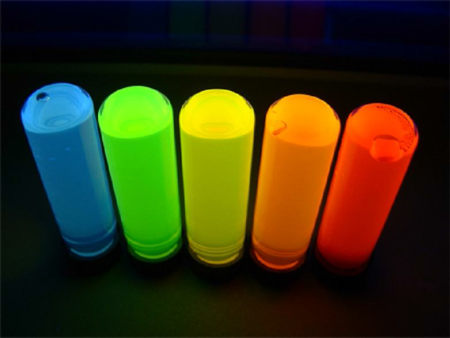Tetrapod quantum dots refer to one of several promising materials niche sectors that recently have emerged from the burgeoning growth area of nanotechnology. Quantum dots are characterized by particles fabricated to the smallest of dimensions from only a few atoms. They measure near one billionth of an inch and are a nontraditional type of semiconductor. They can be used as an enabling material across many industries and are unparalleled in versatility and flexible in form.

Fluorescing quantum dots have many uses including high-definition displays.
These highly efficient tetrapod quantum dots are available across the entire light wavelength from UV to IR spectra and very narrow bandwidth is common. Selectivity of arm width and length is very high allowing different characteristics to be emphasized. Capping with shells and dyes adds desired properties. A custom mixture of quantum dots tuned to optimal wavelengths is easy to create, and projects will have the advantage of unprecedented flexibility and quantities for determining the optimal quantum dot without the time, expense and poor quality of batch synthesis methods.
Quantum dots are finding new uses in high-definition displays, lighting, thermoelectrics, optical switches, modulators, and security inks and paints. Companies like 3M and QMC are predicting that quantum dots will allow LCDs to offer competitive, and in some cases superior, color compared to the best commercial OLED displays currently available.
Recently QMC obtained equipment funding and says that the Los Alamos National Laboratory’s (LANL) Thick-Shell technology will be integrated with a variety of the composite tetrapod quantum dots to develop a line of advanced high performance quantum dots. QMC has teamed with LANL and has jointly written and submitted a proposal for funding to the recent DOE EERE Funding Opportunity for Solid-State Lighting Advanced Technology R&D, which aims to increase performance and market readiness of efficient LED lights incorporating improved quantum dots.
The goal of the scaled and controlled production, and enhanced quantum dot structure is to resolve volume-manufacturing problems that date back over 20 years. The high cost of manual production, the lack of batch uniformity, and the inability to ensure a reliable supply for industrial production have, until this point, restricted the broad commercialization of consumer products that are enhanced by quantum dots.
The combination of thick-shell technology and tetrapod quantum dots is expected to deliver unsurpassed optoelectric brightness and color purity leading to higher resolution and color vitality, and as integrated into the manufacture of displays and lighting units, will enhance performance life expectancy.
For photovoltaics including solar cells, thermovoltaics, near infrared, MEMS, cameras, strain gauges, and other sensor applications, the increased photon absorption by thick-shell tetrapod semiconductor nanocrystals correspond to increased sensitivity, and higher efficiencies due to suppressing recombination.
Quantum Materials has initiated designs for even higher-capacity equipment for future production, and they expect to announce the details later this year. For more information go to http://www.qmcdots.com
Advertisement





